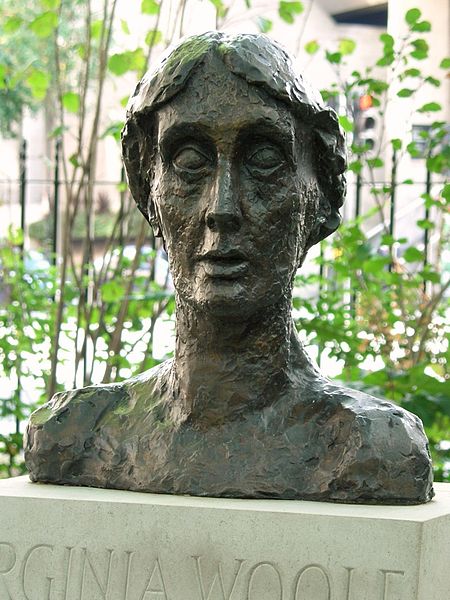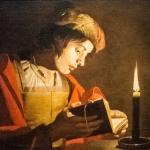When I was a university teacher, my very favorite class to teach was Women Writers. I taught it every spring, from 2010 to 2017, and each time I taught it the course material grew richer for the involvement and contributions of my students. While the reading list changed gradually over the years, there were always a few novels that remained the solid backbone of the class: Jane Eyre, Frankenstein, and Beloved. And every semester, we began the class with the question: why this class? Why women writers?
To answer this question, we always started with Virginia Woolf’s classic, A Room of One’s Own. Nearly one hundred years after its writing, we can see the flaws in the work – the economic privilege, the narrowness of white feminism – but Woolf’s cautious and circuitous observations remain no less relevant today. She talks about the experience of being excluded, as a woman, from the intellectual centers where men dominate; about studying the Great Books written by men in which they muse over the nature of women without once bothering to ask us in on the conversation; about why men are so angry and resentful of women, when it ought to be the other way around. She invites the reader to consider the life of an imaginary “Shakespeare’s sister,” and to see the multiple obstacles such a woman would have faced, in an attempt even to begin to write.
There could be no female Shakespeare, Woolf concludes, not because women are less talented or driven, but because civilization was and is constructed to bar women from the spaces where literature happens.
Some things changed between Shakespeare’s time and Woolf’s – women were able, finally, to keep their own property after marriage, for instance – and more still has changed from Woolf’s day to ours – most colleges now do allow women – but the fundamental image, the idea of a room of one’s own, remains similarly compelling to the young woman writer fighting to carve out a space for herself.
It may be especially compelling for young women writing in a conservative religious community, where women’s education is still sometimes frowned on, and where women are still not permitted to identify themselves apart from domestic relationality. In such a setting, women still know what it feels like to have the spaces of privilege closed to them.
Another respect in which Virginia Woolf’s work remains relevant is in the realm of mental health. It is widely known that Woolf suffered from debilitating mental illness, probably Bipolar II. She suffered also from a series of misfortunes and tragedies, including sexual abuse and the early loss of loved ones. For all one can point to the shades of white upper-class privilege in her work, hers was not an easy life. Her bipolar may have been associated with her incredible periods of creative output, but it was also a torment to her, and in 1941 it finally drove her to take her own life. On a cold day in March she left a note for her husband Leonard, walked down to the River Ouse, filled her pockets with rocks, and walked into the water.
Woolf had the dreamy visionary look of a pre-Raphaelite goddess, and her mother had been a famed artist’s model for the pre-Raphaelite set, so it’s easy to imagine a stylized Ophelia scene, but for anyone who has ever struggled with severe mental illness and depression, the idea of her walk to the river, of the stones weighing heavy in her overcoat pockets, is not artistic and remote. It is painful and personal.
Last week I had the opportunity to visit Monk’s House, the little cottage in Sussex where Virginia lived the latter part of her life with her kindly husband, visited by family members and many literary friends, including T.S. Eliot, and the usual Bloomsbury set. My sister and I went through the rooms of the cottage, saw the books with covers she’d hand-painted to help stave off gloom, saw the real Room of her Own, small and tidy, with a door opening out into the gardens she’d planned meticulously with her husband. Earlier in the day we’d visited the much statelier and more opulent home and gardens of Woolf’s aristocratic friend and lover, Vita Sackville-West, but the gardens at Monk’s House are the sort that one can imagine recreating for oneself, gardens as a small paradise, roses and peonies and irises, a modest apple orchard, a stately elm tree.
It’s wrenching to think of the energy and love she devoted to her life, and to know that the terrible illness still overwhelmed her. It’s wrenching to think of others who have been similarly overwhelmed. We live in such a triumphalist society, with self-help slogans and reminders to bootstrap our way into happiness, but these messages ring hollow in the darkness where many have to find their way.
We made the walk from the cottage down to the river, and found it longer than we’d expected. We’d always imagined that the river just ran behind the house, that she’d slipped out the door and away, but she had half a mile’s walk through marshy fields, to reach the river that led to the sea. And down by the river it was all bleak and stony, surprisingly grim in an otherwise glorious country setting. There was no monument or marker to show that this was where she’d died. Maybe, we thought, it would be considered distasteful to mark the spot. Maybe people would rather remember her beautiful life, not her tragic death. Maybe there’s worry about over-emphasizing her suicide, even encouraging copy-cat incidents.
We wanted to leave some sign to remember her though, because the unmarked riverside seems to accentuate the solitude of that lonely figure who once stood there with her pocket full of rocks. She shouldn’t have had to take that last tormented journey alone.
Woolf was an atheist, and it’s not for me to guess whether she ever called in secret on transcendent powers. But we’d spent the day in places haunted by ghosts, ghosts who comfort us, with their words from decades past, ghosts who fought for us before we were born, and it seems we should try to fight for them now, too, in our turn.
A piece of a broken fence, in the shape of a cross, lay across a low hedge. We pulled it out and stuck it in the rocks by the riverside. No, Woolf didn’t believe in Jesus, but she would have understood that here was one who had suffered, too.
We picked daisies from the riverbank, and red clover, and buttercups, and left a chain and a bunch of flowers on the makeshift lopsided cross. If someone else made the walk from Monk’s House to the River Ouse, that day, they’d see that she’d been remembered there, too.
image credit: commons.wikimedia.org/wiki/File:Virginia_Woolf,_Tavistock_Square,_London.JPG













